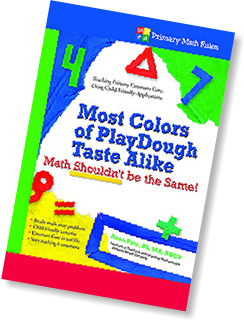Available Now!
at
click to purchase
Why Playdough?
My first book, When Do Dandelions Become Weeds? was an analogy equating dandelions to the same phenomenon in math. When do our primary students who are immersed in and love math suddenly become math haters?
The title for this book was inspired by a true story. After many years of generic play clay, imagine my excitement the day I received my first package of real PlayDoh. I made a classic PlayDoh meal, hot dog on a bun, green peas and blueberry pie. The lid from the can made the perfect pie plate. Imagine my shock as I tasted each of my creations and they all tasted the same! I couldn’t understand how the “real thing” wasn’t any better than the generic.
How does that compare to math? Like PlayDoh, math problems involving fractions, money, number sense and geometry all look very different and yet we teach them much the same. We introduce, explore with manipulatives, practice together and then independently, and assess. We are very impressed with the fancy programs we use and boast about how we’ve incorporated hands on practice which we never were taught as students.
Unfortunately the part we still aren’t getting to is the application of concepts. How often during a day does a problem like 17-_____=9 pop into your head? Never? Have you ever run out of gas? If not then it is probably because you start your car and almost subconsciously subtract how far you are going from how much gas you have to be sure that you have enough. Ever thought about how much math is involved in breakfast: making a pot of coffee, an omelet, muffins – measuring, timing, etc? Of course we don’t think about it but all involve math applications.
The instructional piece missing is teaching our children the necessary math concepts required in Common Core not in isolation, but within the context of today’s children. Their world is filled with television, tater tots and video games. If we use the scenarios that are authentic to kids we can capture their attention and meet our math objectives and goals at the same time.


Available at:
click to purchase

